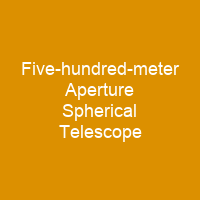The Five-hundred-meter Aperture Spherical radio Telescope, nicknamed Tianyan, is a radio telescope located in Pingtang County, Guizhou, southwest China. It is the world’s largest filled-aperture radio telescope and the second-largest single-dish aperture. The telescope made its first discovery, of two new pulsars, in August 2017.
About Five-hundred-meter Aperture Spherical Telescope in brief

He held the positions of chief scientist and chief engineer of the project. He died on 15 September 2017 in Boston due to lung cancer. The Chinese government spent around USD 269 million in poverty relief funds and bank loans for the relocation of the local residents, while the construction of the telescope itself cost US$180 million. On 26 December 2008, a foundation laying ceremony was held on the construction site. Construction started in March 2011, and the last panel was installed on the morning of 3 July 2016. Originally budgeted for CN¥700 million,: 49 the final cost was CN ¥1.2 billion. The first observations are being done without the active primary reflector, configuring it in a fixed shape and using the Earth’s rotation to scan the sky. The reflector is made of perforated aluminium panels supported by a mesh of steel panels hanging from the side of a geodesic dome, in the form of a dome.
You want to know more about Five-hundred-meter Aperture Spherical Telescope?
This page is based on the article Five-hundred-meter Aperture Spherical Telescope published in Wikipedia (as of Dec. 10, 2020) and was automatically summarized using artificial intelligence.







